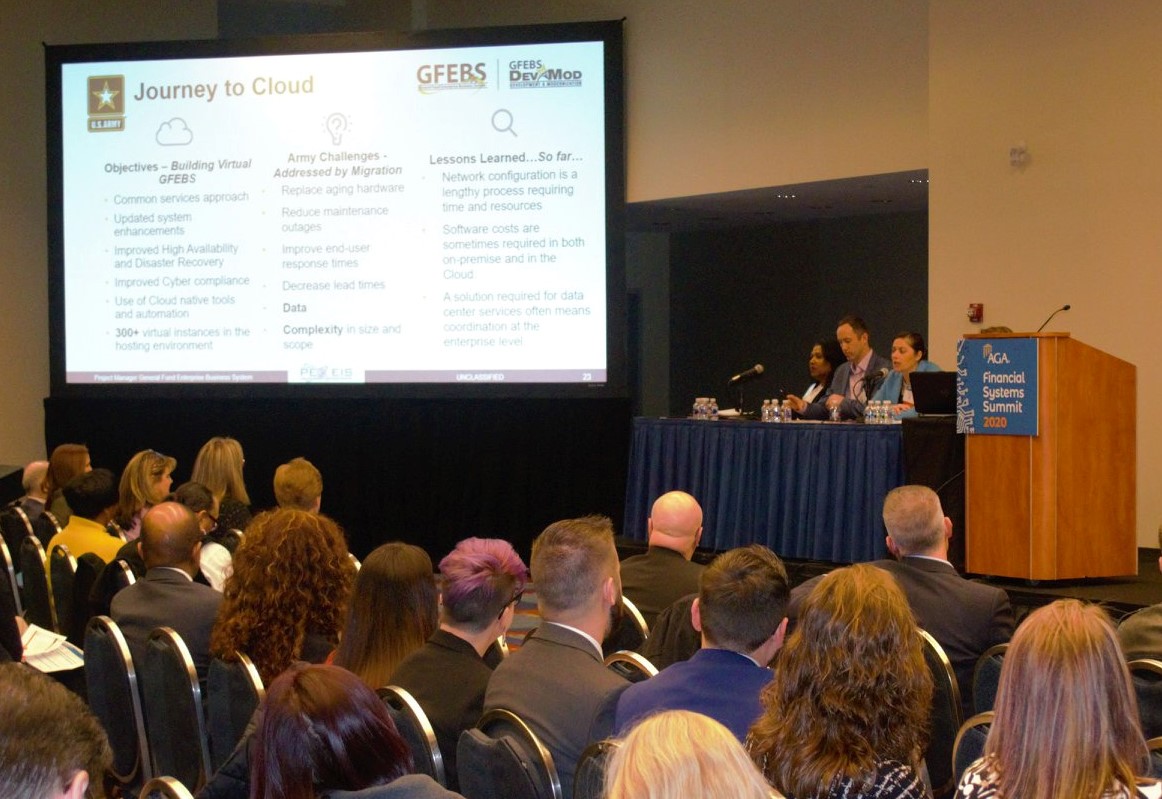

The Army’s General Fund Enterprise Business System will complete its migration to a commercial cloud next fiscal year, while VA will take another shot at moving...
Best listening experience is on Chrome, Firefox or Safari. Subscribe to Federal Drive’s daily audio interviews on Apple Podcasts or PodcastOne.
The Army’s General Fund Enterprise Business System (GFEBS), one of the world’s largest enterprise financial systems, will complete its migration to a commercial cloud next fiscal year as part of a modernization agenda that includes agile transformation and shared services.
GFEBS, which processes upwards of $164 billion in transactions every year and has more than 35,000 users across 71 countries, allows the service to share financial, asset and accounting data with the Treasury Department and the Office of Management and Budget.
Army Enterprise Information Systems (PEO-EIS) next month will begin development in the cloud and expects to move all of its operations to its commercial cloud platform by fiscal 2021.

GFEBS Product Director Heather Putman, speaking Thursday at the Association of Government Accountants’ Financial Services Summit, said that cloud migration would increase agility for Army business needs, improve performance and provide real-time visibility to data.
“When we procure hardware — physical boxes — it takes a long time, and then you have to secure them. So what this gives us the opportunity [to do] is we have more agility to scale up and scale down, based on the needs of our customer base,” Putman said.
That move, she added, will also allow for greater data transparency that will make future audits easier to manage.
“In the past, our focus has been on the hardware, and what can the hardware do and what can the database do. We’re not having those conversations anymore. We’re talking about data. So our focus really allows us to start looking at the data and what the data can do for us,” Putman said.
But for all those opportunities, the move to the cloud also raises new complexities and challenges, including data security and the cost of migration.
“You start to build in the cloud, and as you’re building, you still have to maintain what you have on-premise as well. So you’re doubling costs for the time that you have to transfer your operations from one location to another. And that is costly, and you need to be prepared for that, and then balance the time it takes to move to the environment with the risk,” Putman said. “That’s really what we are in the process of doing now, is how fast can we potentially go without accepting risk that’s going to jeopardize our customers.”

“If a hospital in the Navy has to track accounts receivable and the procurement of medical supplies, and a hospital in the Air Force has to do it, and a hospital in the Army has to do it? Why do we have different service systems? It’s all the same color of money,” Putman said. “Why are we doing it this way?”
Last year, the Army launched a shared service pilot with about 500 DHA personal, and this month brought 350 Navy users onboard. The pilot includes personnel in the Washington, D.C. metro region, Quantico, Virginia, and Jacksonville, Florida.
Putman outlined a “rapid-fire” migration strategy later this year that will move a second tranche of program offices will move to GFEBS in April, a third tranche will migrate in June and a fourth wave will move in September.
Meanwhile, the Department of Veterans Affairs will take another shot at moving to a consolidated financial management system this summer.
Avie Snow, the VA’s associate deputy assistant secretary for financial business operations, said the agency’s first customer will be the National Cemeteries Commission, will go live with the new financial system in July.
But bringing other VA components will be a challenge the agency, which Snow said was “steeped in legacy systems without integration.” The agency has attempted a financial management business transformation twice before, in 2006 and 1998, but both efforts were unsuccessful.
More recently, VA partnered with the Agriculture Department in 2016 to purchase and implement CGI’s Momentum software, but USDA canceled that shared services agreement a year later.
Snow said the VA has learned its lesson from the last consolidation effort, in which VA made the “huge mistake” of beginning with the Veterans Health Administration, which accounts for the vast amount of the agency’s budget.
“It was lack of government oversight. We didn’t step in and do what we needed to do for the VA and essentially, there was no found under there, and the thing just crumbled in on itself,” she said.
Snow also chalked up the agency’s previous failures with financial management business transformation to “change fatigue,” juggling that project with its massive electronic health records migration and supply chain modernization.
“In any given organization, the organization can only take only so much change at one time before you’re really just setting yourself up for disaster,” she said.
This time around, the VA will take a more modest first step in its modernization journey by starting with the National Cemeteries Commission, which has much smaller contracts than VHA.
As for its next customer, Snow told reporters that VA will bring the Veterans Benefits Administration on board in February 2021.
Copyright © 2025 Federal News Network. All rights reserved. This website is not intended for users located within the European Economic Area.
Jory Heckman is a reporter at Federal News Network covering U.S. Postal Service, IRS, big data and technology issues.
Follow @jheckmanWFED
